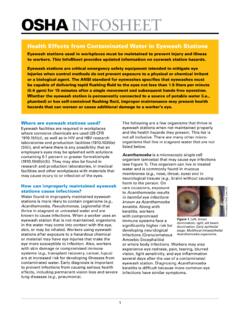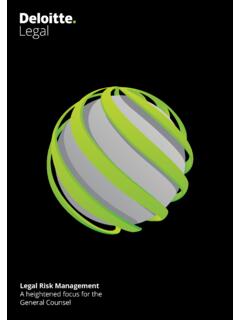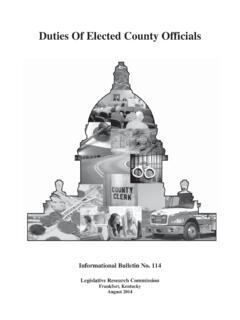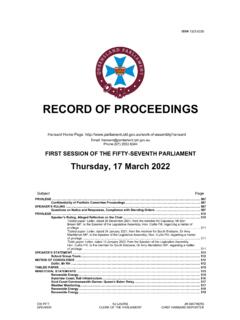Transcription of Cocaine (Canadian Drug Summary) - ccsa.ca
1 Winter 2019 Canadian Drug Summary Cocaine Key Points The percentage of Cocaine use in the Canadian population is low (~2%). The rate of past year Cocaine use in older youth (ages 20-24) is increasing. Despite low prevalence of consumption, Cocaine is responsible for the highest costs to the criminal justice system of any substance in Canada following alcohol. Introduction Cocaine is derived from the coca shrub grown primarily in South America. Extracting Cocaine from the coca plant involves soaking the coca leaves in chemical solvents and crushing the leaves to form a paste. This paste is then treated with oxidizing agents and acids to create Cocaine hydrochloride, commonly referred to as Cocaine is a white powder that is often mixed with substances similar in appearance, such as corn starch. This powder can be taken through the nose by snorting or it can be dissolved and Commonly used street names for Cocaine include coke, coca, coco, snow, Charlie, dust.
2 Snowflake and powder. 3. Freebase Cocaine is made when the hydrochloride is removed from Cocaine hydrochloride, thus liberating Cocaine to a freebase. This is done to create a smokeable form of Cocaine , but the technique for producing freebase Cocaine can be very A more common and less hazardous way to create smokeable Cocaine is to dissolve Cocaine in a mixture of water and baking soda to form whitish, opaque crystals. These crystals are commonly referred to as crack or rock, as the crystals look like When the crack rock is heated, it makes a crackling sound, thus the term crack. 3 Crack or freebase Cocaine can be smoked or dissolved and injected. Using other drugs with Cocaine ,* particularly opiates, either at the same time ( speedballs ) or consecutively, is associated with an increased risk of Effects of Cocaine Use Short term: Cocaine use can cause a state of euphoria accompanied by a large burst of energy (called the rush, flash or high ).
3 If Cocaine is injected or smoked, the extremely intense effect is felt within seconds and only lasts five to 10 minutes. If Cocaine is snorted, the effect is less intense, but lasts between 15 and 30 Other effects include increased energy and alertness;. increased body temperature; increased heart rate and blood pressure;6,7 agitation; paranoia;. suppressed appetite; muscle spasms; stroke; fainting; and overdose. An overdose can involve chest pain, arrhythmia, confusion, convulsions, respiratory depression, coma or * Unless otherwise specified, use of the term Cocaine in the remainder of this document also encompasses crack.. Canadian Centre on Substance Use and Addiction Centre canadien sur les d pendances et l'usage de substances Page 1. Canadian Drug Summary: Cocaine Long term: Longer term effects of Cocaine use are sleep disturbance; weight loss; tolerance to the drug; depression; cardio-vascular problems;7,8 nasal damage (through snorting); kidney failure;9.
4 Throat and bronchial damage (through crack smoking);10 headaches; hallucinations; seizure; and attention and memory disruptions. Maternal use of Cocaine during pregnancy can also result in low birth weight (and related long-term health complications) for ,11 Injecting Cocaine is associated with greater risk for human immunodeficiency virus (HIV) and hepatitis C virus (HCV)12. and crack smoking may be independently associated with HIV and HCV ,14,15. Legal Status of Cocaine in Canada Cocaine is a Schedule I drug under the Canadian Controlled Drugs and Substances Act. Possession of the drug can result in seven years' imprisonment, while trafficking and production of the drug can result in life imprisonment. Driving while impaired by Cocaine is also a criminal offence under the Criminal Code of Canada, as is refusing to comply with drug tests enforced by police officers;. penalties for those convicted are equivalent to those for alcohol impairment.
5 Past-Year Use of Cocaine in Canada General population (age 15+): According to data collected from the Canadian Tobacco, Alcohol and Drugs Survey (CTADS), of Canadians aged 15 and older reported using Cocaine during the past year in 2017, which is comparable to the who reported such use in 2015, but a significant increase from the who reported such use in 2013 (Figure 1).16,17,18 This pattern aligns with an increase in Cocaine use in North and South America during this time ,20. Adults (age 25+): of Canadian adults report past-year Cocaine use according to the 2017. This level of use is a significant increase from the reporting such use in 2013. (Figure 1).16,18. Youth (age 15-19): Rates of past year use of Cocaine for youth ages 15 19 have remained steady between 2013 ( ) and 2017 ( ) (Figure 1).16,17,18. Youth (age 20-24): Unlike the younger age group, past year use of Cocaine for youth ages 20 24 has significantly increased from in 2013 to in 2017 (Figure 1).
6 16,17,18. Students (grades 7-12): In the Canadian Student Tobacco, Alcohol and Drugs Survey (CSTADS) of youth in grades 7 12 reported past-year Cocaine use in 2016 2017, which is comparable to the reported in 2014 ,22 However, in 2017, past year use among grades 10 12 students ( ) was significantly higher than among grades 7 9 students ( ).22 Although the Ontario Student Drug Use and Health Survey (OSDUHS) noted an increasing trend in the use of Cocaine ( in 2015 to in 2017) among students in grades 9 12, this increase was not ,24 Also, the level of Cocaine use has declined since the early 2000s and has remained stable in recent That said, Cocaine use increases significantly with grade, to up to of students in grade 12 using Cocaine in the last year. However, past year Cocaine use among students in grade 12 has not significantly changed since Post-secondary students: Data from the spring 2016 National College Health Assessment Survey, which is drawn from a convenience sample of 41 Canadian post-secondary institutions and therefore is not representative of all post-secondary students in Canada, indicates that 93% of post-secondary Note: All figures identified with a cross ( ) should be interpreted with caution due to small sample size.
7 Canadian Centre on Substance Use and Addiction Centre canadien sur les d pendances et l'usage de substances Pag Page 2. e2. Canadian Drug Summary: Cocaine students had never used Cocaine , had used Cocaine , but not in the past 30 days, and around had used Cocaine sometime in the past 30 Gender: There has been a significant increase in Cocaine consumption by males in Canada from in 2013 to in ,17,18 However, consumption of Cocaine by females has not changed significantly between 2013 ( ) and 2017 ( ).16,18 The 2017 CTADS reports a statistically significant difference between men ( ) and women ( ) in Cocaine use within the past The 2017 CSTADS also reported a significant difference in past year Cocaine use between males ( ) and females ( ) for youth in grades Figure 1: Prevalence of self-reported, past-year Cocaine use among Canadians by age category .. 2013 2015 2017. 15-19 20-24 25+ Overall Source: CTADS 2013, 2015, 201716,17,18.
8 Note: Figures identified with a cross ( ) should be interpreted with caution due to small sample size. Ranking Among Top Five Substances According to CTADS 2017 data, Cocaine was the third most used substance after alcohol and cannabis (besides tobacco), for those above the age of 19 years In contrast, youth aged 15 19. were more likely to consume hallucinogens and salvia or any prescription drug problematically (including to get high) than they were to consume (Table 1). Table 1: Top five substances used in the past year by Canadians #1 #2 #3 #4 #5. Hallucinogens Problematic General Cannabis Cocaine /Crack Alcohol ( ) and Salvia Prescription Drugs Population (15+) ( ) ( ) . ( ) ( ) . Hallucinogens Problematic Ecstasy ( ) . Cannabis Youth (15 19) Alcohol ( ) and Salvia Prescription Drugs Cocaine /Crack ( ). ( ) ( ) ( ) . Hallucinogens Problematic Cannabis Cocaine /Crack Youth (20 24) Alcohol ( ) and Salvia Prescription Drugs ( ) ( ).
9 ( ) ( ) . Cannabis Cocaine /Crack Number Number Adults (25+) Alcohol ( %). ( ) ( ) suppressed suppressed Source: CTADS, 201718. Note: Figures identified with a cross ( ) should be interpreted with caution due to small sample size Canadian Centre on Substance Use and Addiction Centre canadien sur les d pendances et l'usage de substances Pag Page 3. e3. Canadian Drug Summary: Cocaine Past-Year Use of Cocaine Internationally According to the United Nations Office on Drugs and Crime (UNODC), annual prevalence of Cocaine use among the general population in Canada (15-64) in 2015 was relatively high at compared to the global estimate of for 2016. However, rates in Canada remain lower than in the United States ( ), England and Wales ( ), and Australia ( ) (Figure 2).20,26. Figure 2. Prevalence of self-reported past-year Cocaine use among the general population by country Canada (2015) USA (2016) age England and Australia Norway (2016) Mexico (2016) Switzerland age 15-64 15-64 Wales (2016) (2016) age 14+ age 16-64 age 12-65 (2016) age 15- age 16-59 64.
10 Source: UNODC 201820. Note: International prevalence rates are not directly comparable due to variations in survey dates and population age ranges. Associated Harms Hospital data provide an important measure of the impact of substance use on the healthcare system. Data produced by the Canadian Institute for Health Information (CIHI) indicate that the rate of hospital separations or visits (defined as the number of inpatient events ending in discharge or death) where Cocaine use was recorded doubled between 1996 and 2005, from 22 to 45 per 100,000 However, more recent data provided by CIHI have shown a 55% decrease in the number of Cocaine -related hospital separations between 2006 and 2011, mainly due to a drop in admissions among 25 44 year In 2014, Cocaine was attributed to 1,572 hospital stays in Canada for conditions that are wholly ( , Cocaine poisinings) or partially ( , HIV) attributable to Cocaine . This represents of all hospital stays in Canada (not including Quebec) attributable to substance use in Despite a decrease in per-person healthcare costs associated with Cocaine from 2007 2014, $80.







